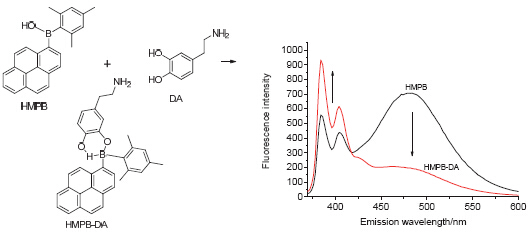| [1] (a) Robinson, D. L.; Hermans, A.; Seipel, A. T.; Wightman, R. M. Chem. Rev. 2008, 108, 2554;
(b) Hyman, S. E.; Malenka, R. C. Nat. Rev. Neurosci. 2001, 2, 695.
[2] Li, B.-R.; Hsieh, Y.-J.; Chen, Y.-X.; Chung, Y.-T.; Pan, C.-Y.; Chen, Y.-T. J. Am. Chem. Soc. 2013, 135, 16034.
[3] Li, L.; Liu, H.; Shen, Y.; Zhang, J.; Zhu, J. J. Anal. Chem. 2011, 83, 661.
[4] (a) Tyagi, P.; Postetter, D.; Saragnese, D.; Randall, C.; Mirski, M.; Gracias, D. Anal. Chem. 2009, 81, 9979;
(b) Koehne, J. E.; Marsh, M.; Boakye, A.; Douglas, B.; Kim, I. Y.; Chang, S.-Y.; Jang, D.-P.; Bennet, K. E.; Kimble, C.; Andrews, R. Analyst 2011, 136, 1802;
(c) Zhou, J.; Wang, W.; Yu, P.; Xiong, E.; Zhang, X.; Chen, J. RSC. Adv 2014, 4, 52250;
(d) Liu, Q.; Zhu, X.; Huo, Z.; He, X.; Liang, Y.; Xu, M. Talanta 2012, 97, 557;
(e) Wei, X.; Chang, C.; Li, J. Acta. Chim. Sinica 2013, 71, 951 (in Chinese). (魏小平, 常川, 李建平, 化学学报, 2013, 71, 951.)
[5] Zhao, Y.; Zhao, S.; Huang, J.; Ye, F. Talanta 2011, 85, 2650.
[6] Liu, L.; Li, S.; Liu, L.; Deng, D.; Xia, N. Analyst 2012, 137, 3794.
[7] (a) Lee, H.-C.; Chen, T.-H.; Tseng, W.-L.; Lin, C.-H. Analyst 2012, 137, 5352;
(b) Su, H.; Sun, B.; Chen, L.; Xu, Z.; Ai, S. Anal. Methods 2012, 4, 3981.
[8] Nikolajsen, R. P.; Hansen, Å. M. Anal. Chim. Acta 2001, 449, 1.
[9] Zhang, L.; Teshima, N.; Hasebe, T.; Kurihara, M.; Kawashima, T. Talanta 1999, 50, 677.
[10] (a) Ma, Y.; Yang, C.; Li, N.; Yang, X. Talanta 2005, 67, 979;
(b) Mu, Q.; Xu, H.; Li, Y.; Ma, S.; Zhong, X. Analyst 2014, 139, 93;
(c) Zhao, D.; Song, H.; Hao, L.; Liu, X.; Zhang, L.; Lv, Y. Talanta 2013, 107, 133;
(d) Yu, C.; Luo, M.; Zeng, F.; Zheng, F.; Wu, S. Chem. Commun. 2011, 47, 9086.
[11] (a) Jackowska, K.; Krysinski, P. Anal. Bioanal. Chem. 2013, 405, 3753;
(b) She, G.; Huang, X.; Jin, L.; Qi, X.; Mu, L.; Shi, W. Small 2014, 10, 4685.
[12] Feng, J.; Tian, K.; Hu, D.; Wang, S.; Li, S.; Zeng, Y.; Li, Y.; Yang, G. Angew. Chem., Int. Ed. 2011, 50, 8072. |
